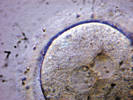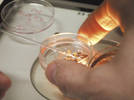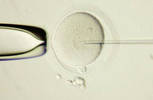Female Interventions
Step by Step
- Preliminary investigations and support
- Hormone substitutes used
- The stimulation phase
- The hCG injection (Human Chorionic Gonadotrophine or the pregnancy hormone )
- The egg cell pick-up
- The role of the man
- In the lab: IVF or ICSI
- The embryo transfer
- Transfer of thawed embryos
- Preparation for pregnancy
- Follow-up of pregnancy
In the laboratory: IVF or ICSI
This is the essence of IVF: the fertilisation takes place in the lab instead of the fallopian tubes of the woman.
A few hours after the pick-up, the sperm cells are put with the egg cells and placed in an incubator. The incubator reproduces the environment found within a fallopian tube; the same temperature, humidity and atmosphere.
A day later, they are examined under the microscope to see whether fertilisation has taken place. If it has, another day is waited, to see if the embryos continue to develop.
The quality is determined and finally on day three or five after IVF, one or two embryos are replaced into the uterus.
It can also happen that the formation of the embryos is less successful in which case an appointment with the gynaecologist will be hastily arranged.
Classic IVF:
The classic IVF is performed by placing sperm and the egg together in a culture dish. If successful, one or more embryos will develop.
Although fresh sperm is preferred for the purposes of IVF, this method can also be performed using thawed sperm from ejaculate. When using donor sperm, this is the only way of performing the procedure.
ICSI:
Since the 90's, a new technique has been available to fertilise sperm cells: ICSI (pronounced 'iksi') or intracytoplasmic sperm-injection. This advanced method was developed in UZ Brussel and since then has been implemented world wide.
ICSI is particularly useful for couples where the man is less fertile. If his ejaculate contains too few useable sperm for the classic IVF method, then ICSI can be applied.
First a suitable sperm is selected under the microscope. This is sucked up with an unimaginably thin glass pipette and injected directly into the centre of the egg cell. The pipette penetrates the egg cell and the sperm is expelled into it. The fertilisation then takes place mechanically and only one sperm is required.
ICSI is a delicate but highly effective procedure. Of all the eggs collected at pick-up, 80% are generally mature enough to be fertlised in this way. 10% of the eggs are lost in the process, but 70% from those which survived the procedure will develop into embryos.
The result is that approximately 50% of the eggs retrieved at pick-up can be used for embryo transfer. In other words, the chances of pregnancy are just as high as with classic IVF.
Quality control in the lab:
The Centre for Reproductive Medicine UZ Brussels has been awarded the ISO-1589 accreditation, which amongst other things means that all steps of the process are checked by two people, apart. During your treatment, you will be asked your name many times: now you know the reason why.
You can be 100% sure that the egg cells, sperm and embryos which we work with during your IVF treatment, are yours and your partners'.
Read the Guide
The guide is available as downloadable PDF documents.
Click on the chapters to view the PDF's.
- What we know. Theory of fertility.
- Science and the creation of new life. In vitro fertilisation and other methods of assisted conception.
- Cross Border. IVF for non-resident patients.
- More than medical. Ethical, social and health aspects of IVF. Possible consequences for the child; the ethical implications of a prenatal diagnosis; how to deal with treatment with regards to your friends and family; what happens with the frozen material...
- Giving Life, Sharing Life. Sperm donation, egg donation, embryo donation.
- On the medical fringe. Practical information.





